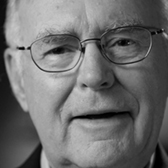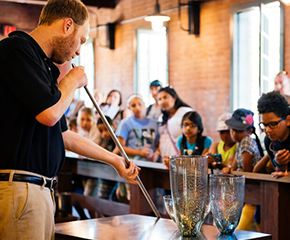
The Chemist
Gordon Moore
The Intel co-founder says forget about the possibility of failure and go for it.
In the 1950s, before Silicon Valley was Silicon Valley, a young chemist named Gordon Moore was in someone else’s lab trying to develop efficient, affordable silicon semiconductor devices. (Catch the “silicon” connection?) In a bold move, Moore decided to leave that lab and form his own company with seven coworkers and some help from financial backers. That little venture became Fairchild Semiconductor in 1957, the place where the first commercially practical integrated circuit was invented.
By 1968, Moore and colleague Bob Noyce, a physicist and coinventor of the integrated circuit, decided it was time to risk it all again, throwing caution and a comfortable lifestyle to the wind to form yet another startup. They called it Intel Corporation, which went on to produce the world’s first microprocessor and become the world’s largest producer of computer microchips—those mysterious, tiny, high-tech wonders that power everything from our smartphones to our laptops, kitchen appliances and the antilock brakes on our cars, and even help us find our lost pets.
Moore is now Intel’s chairman emeritus. When The Henry Ford sat down with him as part of OnInnovation and its Collecting Innovation Today initiative, Moore talked about his early days in the Valley and the easygoing attitude toward taking big risks. He also shared what he wants today’s budding engineers and entrepreneurs to know about the strong connection between great failure and great success.
OI: The semiconductor industry. Take us back and sort of paint the picture of what it was like. Was it like sort of the gold rush? Everybody out in California inventing the future? The big bang of the high-tech business?
GM: Pretty much so. Maybe the big bang was the invention of the transistor at Bell Laboratories. But in particular, silicon technology was lagging behind. The original transistors were made of germanium, which was an easier material to work with. On the other hand, it didn’t make as good transistors.
So, when we set up Fairchild, we decided to pursue the diffuse silicon transistor. And that was a very important technology. It was something that made transistors in a batch manner so all the costs weren’t on one particular piece of silicon; you could spread them across several pieces of silicon.
And it looked like a much more economical way to make a much better transistor. Just required a lot of technology to be developed. And that’s essentially what we did in the early days of Fairchild. Then, as we started exploiting this technology, we developed a whole bunch of other opportunities that resulted in, really the formation of what generally is called Silicon Valley today.
It was the development of the engineer-entrepreneur. The engineer would see the opportunity, run off and get financing, set up a company to exploit it. It was really the blossoming of the venture capital industry along with the technology out here that created the phenomenon known as Silicon Valley.
OI: Was the engineer-entrepreneur focused more on personal gain and wealth or seeking better places to innovate?
GM: It’s always difficult to try and guess what people’s motivations were. I suspect some of it was make your own fortune commitment. But more than that, it was wanting to exploit a technological idea in an environment you controlled. A company like Fairchild just couldn’t pursue all these opportunities.
If an engineer came up with a new idea, it was rather frustrating to see his/her idea wither on the vine while the business of the company was being pursued as diligently as it could. It was much more attractive to spin off.
Financially, none of them felt they could suffer either. That was another thing that happened. It became relatively low risk to set up your own company. In this area, failure wasn’t a stigma. You could go out and set up a company and fail and get a job the next day at another company, probably at a higher salary because of your experience.
And that’s been the case all along. Failure has not been something that has been negative here. I think that’s one of the big advantages Silicon Valley has had. Certainly over some, such as the European environment, where nobody wants to go out and be a part of a failure.
Here, people just didn’t seem to give a darn.
OI: What motivated you, drove you?
GM: You know, what got me in the technical area was when my neighbor got a chemistry set when I was about 11 years old. I found out you could do some really neat things with that. You can’t get those chemicals anymore!
I decided very early I wanted to be a chemist, not necessarily knowing what they did.
I did have a home laboratory where I turned out small production quantities of nitroglycerine, which I made into dynamite. A couple of ounces of dynamite make a fantastic firecracker. So, I kept my interest in chemistry. Then, I gradually got into the more technical aspects.
I guess to make a bigger bang was more my motivation.
OI: You’ve certainly made a couple big bangs. Can you share stories behind some of the major breakthroughs? The planar transistor, the invention of the integrated circuit?
GM: Depending on the planar transistor technology, the extrapolation to the integrated circuit was relatively straightforward. You make planar transistors; you could start making integrated circuits soon after that invention.
There were a couple of other bits of technology. There was something called epitaxial growth, which was a new way of growing silicon that contributed greatly to making integrated circuits practical. Before that, you could make them, but it was a messy operation requiring high temperature treatment of very thin wafers. Ended up looking like potato chips when they came out of the furnace.
With epitaxial growth, you could take a wafer and grow a layer on top of it. Grow a thin layer of the kind of material you wanted. And that made the whole integrated circuit process a lot easier and made much better devices. But there were a lot of other things along the way, a lot of innovation required as we went from single transistor to hundreds, thousands, millions and billions.
I remember in the early days of Fairchild, Bob [Noyce] and I, we split up the technology, and I had a couple areas where we had problems. For example, in our diffusion area where we were putting impurities into the silicon, the electrical properties of the devices weren’t coming out right. And we were struggling to find out what the heck was causing the variation.
One day, Bob suggested that I de-plate nickel on the back of the wafer. For no good reason I could think of. But, I’d run out of ideas, so I said, “OK, I’ll risk putting nickel in one of the furnaces.”
I put it in and the electrical properties came out perfect. I didn’t know why at the time; I’m not sure he did either. But his suggestion solved that problem.
He did it again with the metal we were using for interconnections on the transistor. We wanted to find a metal or alloy that would make good contact at two different kinds of silicon, the P-type and the N-type that are necessary to make a transistor. But this requires metals that have different electrical properties when they get dissolved in the silicon. So, I was working with complicated alloys, the silver and gallium and one thing or another. Kind of going up and down and not making much progress. Bob came by and said, “Why don’t you try aluminum?”
Everybody knew aluminum interacts with silicon to make P-type. You didn’t want a P-type contact to the N-type silicon. Not having anything better to do, I tried it. Lo and behold, made good contacts to both the N-type and the P-type.
I think it was five years later before I understood why and before the industry understood why. But, switching to aluminum made the thing practical.
OI: Moore’s Law states that the number of transistors the industry can place on a computer chip will double every 18 to 24 months. Tell me something about the scientific law you authored in 1965 that you’ve never told anybody.
GM: This was an article in one of the industry throwaway magazines—its 35th anniversary edition. I was in a unique position to see what was happening with the development of integrated circuits. Up until then, they’d just been expensive. They didn’t compete commercially.
But I could see things were changing—that this was going to be the cheap way to make electronics. And that was the art really. The purpose of the article was to get across the idea that the trends in the technology are going to make electronics cheap because of increased levels of integration. And I just took the first few points. They’d been about doubling every year since the first planar transistor. And we were making the things in the laboratory then with about 60 components on it.
So, I extrapolated for 10 years and continuing to double every year. Went from 60 to 60,000, which is pretty wild. And had no idea it was going to be at all accurate. I was just trying to get the trend in there.
One of my colleagues named it Moore’s Law. I couldn’t say the term for 20 years. It was embarrassing. I finally have gotten relaxed with it. In fact, I Googled it recently, and I Googled Murphy’s Law, and there were twice as many references to Moore’s Law. So, I’m better known than Murphy at this stage of the game.
OI: What did you do at Intel to make it easier for people to invent, try things like you did, not to be afraid of failure?
GM: We tried to just preserve an environment where people could do new things if they were consistent with the business model. For example, when one of our engineers invented the microprocessor. For years, the industry had talked about putting a whole computer on a chip. Well, that was way out in the future. But one of our engineers is looking at a family of calculators that we were asked to produce. Saw, heck, I could make a general purpose computer architecture, do all the calculators and make it useful for a variety of other things, too. And it wouldn’t be much more complex than the memory chips we’re making. That was really an intellectual breakthrough. He saw the opportunity to make what has become the microprocessor and we pursued it. And it became one of Intel’s principal businesses by far. We’ve always tried to encourage our engineers to think like that and come up with completely new ideas. And they’ve been successful often enough that the company has grown quite significantly.
OI: What’s something that was just an absolute failure for you?
GM: Our watch business. Well, again, as with calculators, watches were something where you could make a chip and sell it in large volume. And we were the first company in the liquid crystal watch business. One of the first ones out, too. We acquired a very small startup that had the liquid crystal technology and started trying to make watches. By the time we got out of the business, the chip was costing us less than the push buttons on the side for setting the time. So, that was, you know, a failure as a business. I kept one of the latest model developmental watches, which I referred to as my $15-million-dollar watch for many years.
OI: You’ve been the engineer in the lab doing the research and development, the manager, the entrepreneur and the chairman of the world’s largest producer of the microchip. What did you do to keep people motivated and happy and coming up with the innovations?
GM: You give good people the opportunity, and they go out and do the innovations. It’s hard to control. In fact, I think the more you control it, the more you’re likely to stifle innovation. It requires the people be given a fair amount of latitude if they’re going to proceed and come up with new and different things. Give them sufficient flexibility and ownership so they can really have an intellectual contribution to make to the project. So they can feel they’ve accomplished something when they’re done. We also tried to prevent hierarchy. Free flow of information is extremely important. There are so many technical decisions, they have to be made by the people that understand technical problems.
OI: We have a bunch of schoolkids in the room. What would you tell them?
GM: Find something that they really enjoy doing and pursue it. Things are changing so rapidly that the first thing they ought to do is get a good education with a strong basis in the fundamentals. The details you learn you’re probably not going to use for very long. But the fundamentals don’t change. And during your career, you’ll probably have three or four really different jobs. But you won’t depend upon exactly the same skills. So, you have to be in a position to be flexible.
OI: And if someone wants to be an engineer?
GM: It can still be a great career. On the other hand, it’s harder for the individual to do something great anymore. It tends to be done by fairly large teams. The complexity of the products is so great now that no one individual can really span it.
OI: Is there still something about America that makes this a great place for innovation?
GM: I think there is. The lack of fear of failure is an important part of it. People are willing to try things. They figure if they don’t make it, they can do something else. The availability of venture capital is important; people with a good idea can generally get it financed. I hope that continues to be the case. And there are a lot of successful examples where engineers with no previous business experience have succeeded in setting up major companies. I think this has developed an entrepreneurial environment unmatched anyplace else in the world.
This interview was originally published in the January-May 2013 issue of The Henry Ford Magazine.Lack of fear of failure is an important part of it. People are willing to try things. They figure if they don't make it, they can do something else.Gordon Moore



